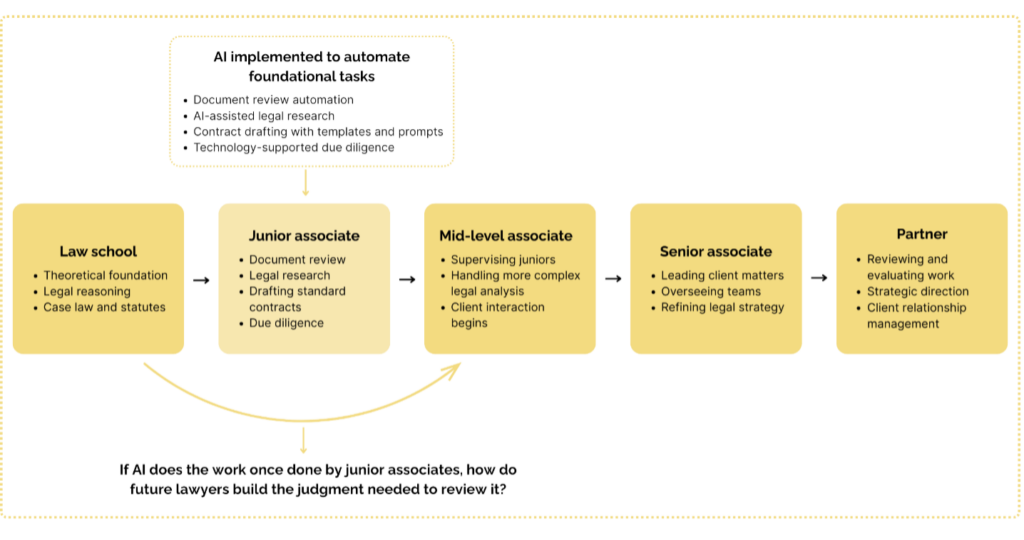As artificial intelligence becomes more integrated into legal workflows, a structural gap is emerging—one that lies between the education law students receive and the knowledge required to navigate the profession in an AI-supported environment.
The traditional path from law school to partnership
Traditionally, the career progression in law firms follows a relatively predictable trajectory. Law school provides a theoretical foundation, combined with training in legal reasoning, case law, and statutory interpretation. Once graduates enter the firm as junior associates, they begin to apply this foundation to real-world legal work—primarily through tasks that are repetitive but essential.
This early-stage work often includes document review, legal research, drafting standard contracts, and conducting due diligence. These tasks serve a dual purpose: they add value to the firm while providing junior lawyers with the deep, structured exposure to case materials, contract frameworks, and procedural patterns that build professional judgment over time.
As associates gain experience, they begin to supervise others, take on more complex legal analysis, and interact more closely with clients. By the time they reach senior associate or partner levels, a significant portion of their work involves overseeing the quality of legal output delivered by others—often reviewing, editing, and evaluating the work that they themselves once carried out.

This hierarchical model presupposes that partners and senior lawyers are well equipped to evaluate junior-level work because they have done it themselves, often many times over.
AI shifts the foundation of legal training
However, with the adoption of AI in legal services—especially in tasks such as document review, research, and drafting—this traditional learning structure is disrupted. AI can now perform many of the tasks that were once the entry point for junior lawyers. The efficiency gains are clear, but what is less often discussed is the effect this has on professional development.
If AI is tasked with producing the bulk of what a junior associate would normally do, and if young lawyers are instead placed in roles of oversight or judgment without ever having done that foundational work themselves, a gap is created. It is not only a gap in experience, but in the practical understanding of how legal work is constructed, interpreted, and challenged.
Evaluating the output of AI systems requires more than a theoretical understanding of the law—it requires the same kind of practical insight that comes from having performed the task manually. Without this insight, lawyers may find themselves relying too heavily on the AI’s outputs without the skills needed to question or correct them. In turn, this could erode both the trust clients place in legal professionals and the firm’s ability to maintain high standards.
A profession in transition
The profession now faces a critical question: if AI replaces much of the work that formed the basis of legal apprenticeship, how will the next generation of lawyers learn to think like lawyers?

This is not an argument against the use of AI. On the contrary, the benefits of AI are significant and undeniable. But it is a call to reflect on how legal education, training, and professional development must adapt. Firms and legal educators will need to reconsider how knowledge is built when the traditional ladder of experience no longer exists in the same form.
In this new era, legal professionals will be required not only to understand the law, but also to understand the tools they are using—and the assumptions behind them. Without this, there is a risk that AI becomes a black box, and lawyers lose the ability to effectively evaluate, correct, and ultimately take responsibility for the work produced.
As we move forward, the gap between law school and practice in an AI-enabled world will need more attention—not just from those implementing technology, but from the entire legal ecosystem.
